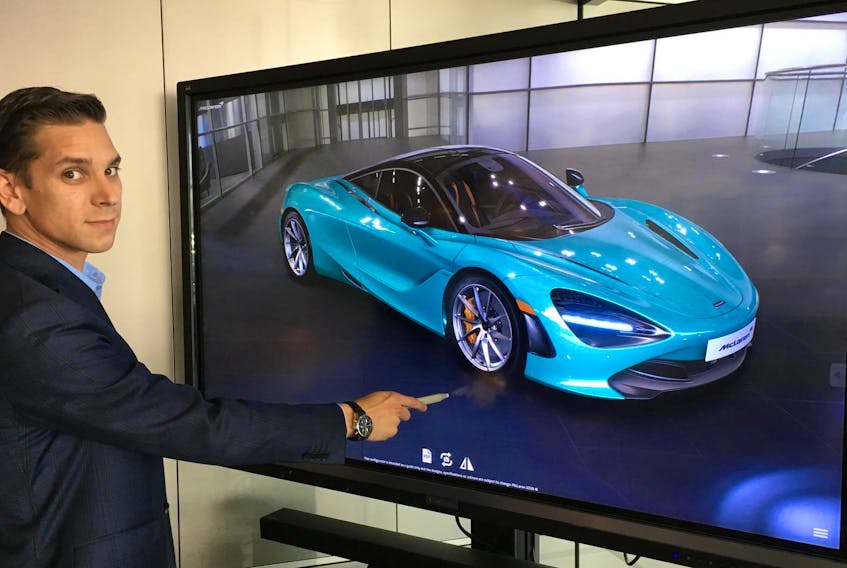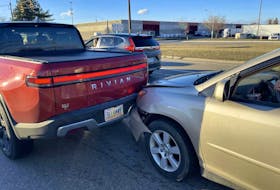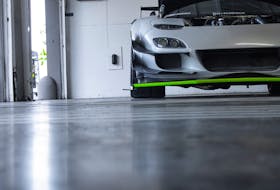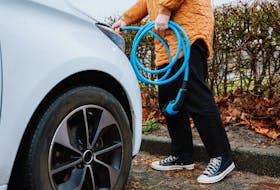TORONTO, Ont. — Choosing your new car at McLaren Automotive’s Toronto dealership is a lot like playing a video game — Gran Turismo or Forza — except in this game the money is real.
You stand in front of a large 4k touchscreen. On it is a photo-realistic 3D model of your car in some beautiful location, say, next to the ocean in Lisbon, or at McLaren’s sci-fi headquarters in England.
With your finger you can spin the car around, open a door, zoom inside and look at the steering wheel or get a close-up of the carpet stitching.
If you don’t like what you see, you can change it: purple pearlescent paint or gold wheel bolts or red leather.
This is MARC, the McLaren Automotive Real-time Configurator, and it’s a glimpse into the future of car shopping. Announced in September, it has already proven to be good for business.
“I think it’s justification for spending the extra money because (customers) can actually see what (any option) is going to look like on their car,” said Mark Basili, sales executive at McLaren Toronto. “Before, it was me saying, ‘imagine this.’”
Better vehicle configurators
Better car configurators are enabling new-car purchases that are happening entirely on smartphones or tablets.
“Where we’re at right now in terms of the technology of car configurators has been a huge benefit to not only the dealers and manufacturers, but also customers, in terms of clarity on design,” Basili said.
Before MARC, he couldn’t really show buyers what a colour or option would look like in-person because McLaren never has many cars in stock, so the virtual tool is a big help.
Tesla’s sales model relies on customers configuring and ordering cars online.
Elon Musk recently wrote on Twitter than anyone who buys a car without doing a test-drive has three days — instead of the usual one day — to return it for a refund.
Buy a new car from the comfort of your couch and if you don’t like it, return it for a refund — just like you’d do if you bought a pair of jeans online.
You put on these gloves and wear your little headset and you can get inside the cars and physically touch the things you want to change.
-Mark Basili, McLaren Toronto
Genesis, Volvo launch online-centric sales
Genesis, Hyundai’s new luxury brand, launched with a similar online-centric sales model. On the website for the G70, you’ll find a big “Build and Purchase” button that takes you through the process of choosing paint and trim options.
Deliveries have already started for Volvo’s new subscription service — Care by Volvo — that lets customers sign-up for a new car online like they’d sign-up for a cellphone plan.
“People are looking for simplicity, convenience and peace of mind; it’s now a few clicks away,” said David Carroll, national sales manager for Volvo Canada.
A V60 station-wagon subscription costs $949 per month, and the transaction takes place almost entirely online, right up to and including entering your credit card information.
“I think there is a segment of people who are very interested in an online transaction,” Carroll said. “If you can save time, know you’re getting exactly what you want at a very clear and reasonable price, why not?”
See what you’re getting
All of these online sales models only work if buyers can see exactly what you’re getting.
Tesla, Genesis and Volvo have useful 2D configurators that provide a decent picture of what a particular colour or option looks like, but there’s a lot of room for improvement.
They’re nowhere near as useful as McLaren’s new 3D system. The catch, however, is that MARC needs to run on a dedicated computer. It’s not something you can use in a web browser, at least not yet.
For too long, car configurators have been terrible, crash-prone webpages that are almost as much of a headache as they are helpful. Hopefully, this is all about to change.
Basili has no doubt that this kind of technology — 3D configurators, even virtual reality headsets — will enable more online vehicle purchases in the future.
Are salespeople jobs at risk?

But, he’s not worried they’ll put him out of a job at McLaren Toronto. “For the really high-end, exclusive vehicles, there will always be a human element involved,” he said.
For mainstream brands though, salespeople could become a much smaller part of the process. It’s happening in almost every industry, from Amazon’s cashier-less grocery stores, to San Francisco’s robo-chef restaurants, to those infuriating touchscreens airlines began installing in terminals years ago.
Virtual-reality headsets could put you in the driver’s seat of any car, anywhere in the world, while augmented-reality glasses — like Microsoft’s HoloLens — could let you see how two different cars might look in your driveway.
Basili has already seen this kind of technology in action, albeit in prototype form.
“You put on these gloves and wear your little headset and you can get inside the cars and physically touch the things you want to change,” he said.
For anyone who grew up with PlayStation and who spent hours playing racing games, this is all going to feel like a natural evolution, obvious even.
But for those who didn’t, expect a bit of learning curve.









